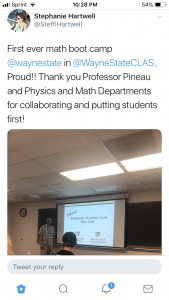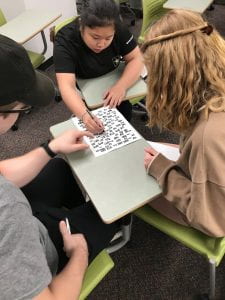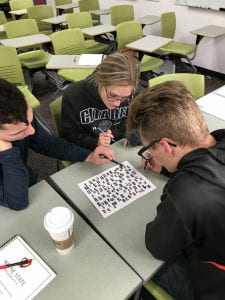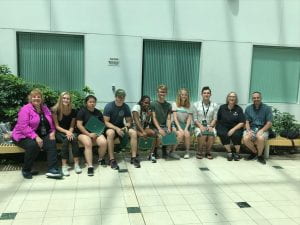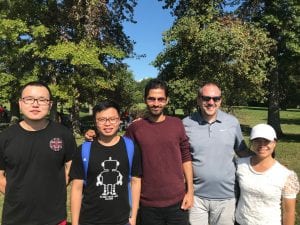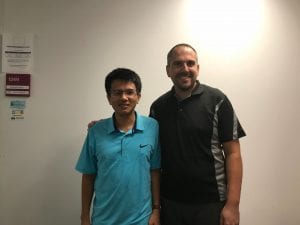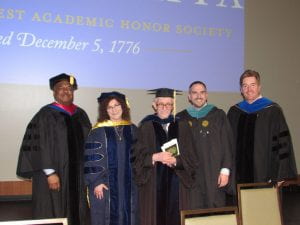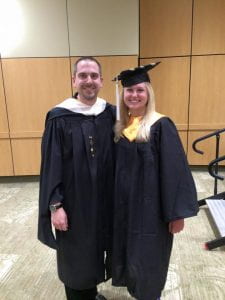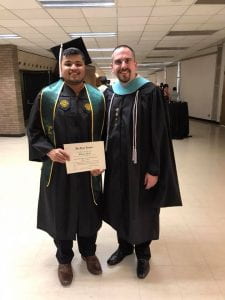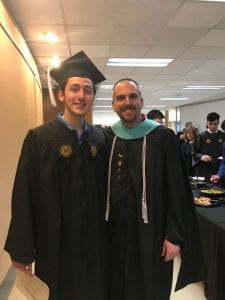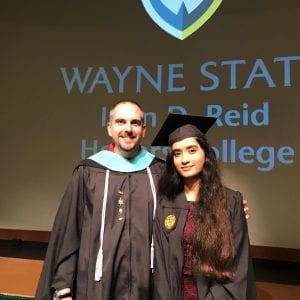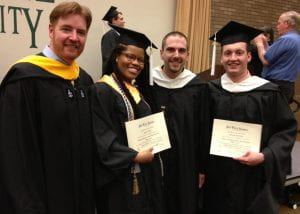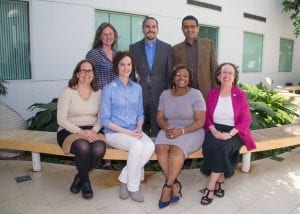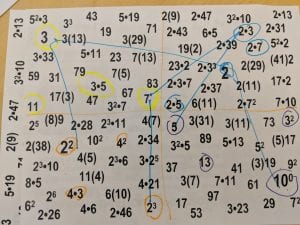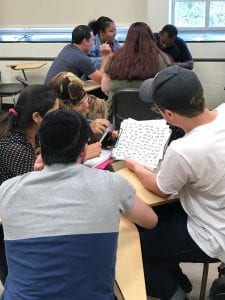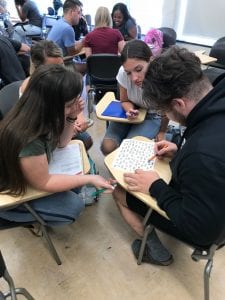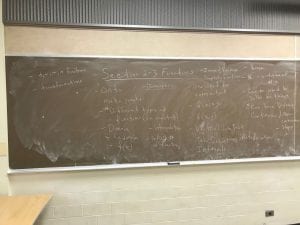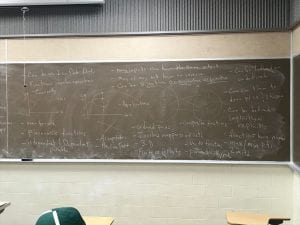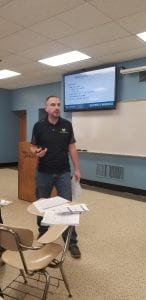Mathematics Placement Exam Boot Camp
In the summer of 2019, thanks to the generous support of a Physics Alumna donor, and in collaboration with the WSU Departments of Mathematics and Physics, we were able to offer a 4 week Boot Camp for eligible entering freshmen whose majors are in Math and Physics and other related fields. For our first Camp, we welcomed 6 students and one volunteer Peer Mentor (& WSU Graduate!!). The goal is for them to take the mathematics placement exam after the Camp and place in Calculus I (MAT 2010). The typical sequence for students is MAT 0993 (Beg. Alg.), MAT 1050 (Alg. with Trig.), MAT 1800 (Pre-Calc.), MAT 2010 (Calc.).
Read the Today@Wayne Story about the 2019 Boot Camp!
Results:
Among the six students:
- 2 placed into Calculus I as desired, thereby skipping MAT 1050 & MAT 1800
- 1 placed into Pre-Calculus, thereby skipping MAT 1050
- 5 of the six students showed an increase in their overall placement test scores as a result of the Camp.
Dean Stephanie Hartwell even gave me a shout out on Twitter!
Here, the students are doing the Numbers Game Icebreaker.
Here is the photo with the students on the last day of Camp.
Mentoring
In addition to teaching, I have had the privilege of mentoring Graduate Teaching Assistants (GTAs) each fall term, with the exception of my first year of hire. These GTAs have been new to the department, some with prior teaching experience, some new to the country, are assigned to me as my mentees for the term. They attend class with me twice a week, grade homework, write at least one quiz and exam, teach two lessons on their own during the term, and meet weekly with me to talk about a range of topics. I learn from the mentees as they learn from me. Below are photos of all my mentees from 2014 to 2019.
I also present at my department’s orientation for new GTAs in August each year. My presentation covers an introduction to teaching at the university.
All new GTAs are required to take our MAT 5992 course, which covers teaching undergraduate courses in our department. The course introduces them to many aspects of teaching from classroom management, record keeping, and planning lessons. I have been asked to present the last few years, as a guest lecturer, on teaching portfolios and teaching statements.
The WSU Math Society
Looking to garner more student involvement in the department, I helped to start a new student organization in our department called the WSU Math Society. Composed of undergraduate and graduate students, this organization holds semi-regular meetings, does volunteer work in the Detroit area, engages in recruitment events for prospective students, works STEM and Pi Day activities, and spreads the beauty of mathematics to everyone. As a co-faculty adviser, I support these students by providing advice and counsel, direction on projects, and as a resource for many facets of their work.
Phi Beta Kappa
Phi Beta Kappa, or PBK, as it is usually called, is the nation’s oldest and most prestigious honor society. Each year, we induct anywhere from 70-90 undergraduate students who represent the top 1% of their graduating class. These students maintain very high GPA’s but have also taken a broad range of liberal arts and science courses in addition to other carefully regulated stipulations. Every May, we honor these students, together with their families and faculty mentors, in an initiation ceremony. I serve as the secretary-treasurer for the Gamma Chapter at Wayne State. In this role, I help to review transcripts of potential initiates with other PBK faculty, and send out the official invitations to all students. I enjoy this work very much and perhaps the most rewarding part is when I get to see former students bring inducted.
In this photo taken at the 2018 initiation we have, from left to right: WSU Provost Keith Whitfield, Chapter President & Professor of Psychology Lisa Rapport, Chapter Historian and Professor Emeritus Martin Herman, myself, and President-elect & Senior Lecturer of Mathematics Chris Nazelli.
Here are some photos with former students of mine who were inducted at previous ceremonies.
The right most photo in the second row is particularly noteworthy as both students pictured with Chris Nazelli and I are former Math Corps students who we both know very well.
A teaching-centered mission
While my position does not specifically define research as part of job, I have worked on a few projects within my department as well as with colleagues from other areas of the university.
Since teaching is my primary responsibility, student success has been at the center of my teaching philosophy from the start. Many of the classes that I teach have students who enroll in them because their program requires it. Many have opinions of math that are far less than favorable, and still others who enjoy the challenge. Either way it’s spun, I have to look for ways to motivate my students to be successful.
Provost’s Fellow
During the spring of 2015, I was selected to be a part of the inaugural class of Provost’s Fellows partly due to my work with the Math Corps as I mentored students, but also my work as a lecturer. Part of what I ask students to do is to commit to excellence on the first day of class. This is not the typical “I have high expectations for you” speech but rather their planning out how they will pass my class. The ultimate hope of course, is that this sets into motion a plan for success later on. More on this later…
As part of this group, we had exciting ideas for how to increase graduation rates and improve retention, which was really the reason for the group’s formation. The pinnacle of our collaborative efforts was the planning and execution of the Provost’s Summit on Student Success held in the spring of 2016. This summit featured speakers from both Wayne State and other institutions who highlighted student success strategies for all participants to try.
The Success Policy
My first teaching assignment was with the MAT 1050 course, known as Algebra with Trigonometry. This is a 5 credit course and for all intents and purposes, is considered to be a remedial course. My department runs quite a few sections each fall and winter term and students take it as part of the requirements for programs but also to get to the Calculus sequence.
I was having a hard time reaching the students who were not doing as well. I had tried extra office hours, speaking with them briefly after class, emails, etc. but still nothing. Sharing my concern with longtime senior lecturer Patty Bonesteel, who became a mentor for me early on, suggested an alternative. She told me that after she returns a quiz or exam, students who score below an 80% have to come in and see her to get help. If they fail to do this, she does not return anything to them until they do (really up to the next exam and then starts the process over again). I gave the idea some thought and implemented it the next term.
As time went on, I noticed that some students began to come around and talk with me. Realizing that my office hours did not always line up with students’ schedules, I offered the Mathematics Resource Center (MRC) as an alternative just so long as the tutors signed the quiz or exam. I really liked the effectiveness of this policy and I wanted to add it to my syllabus and so I did, under the guise of the Success Policy.
As part of the first week introduction to my course, I literally walk students over to my building, show them where my office is located as well as the MRC’s location. The MRC Manager also provides a brief orientation to my students on how to use the MRC, which is free, by the way. Doing this has significantly cut down on the excuse of not knowing where the building was located thereby limiting a student’s ability to get help. There are no excuses, not in my classes.
As an added layer to my students’ success, I ask them to make a plan for how they will be successful in my class. The assignment is broken up into the following four parts:
Part 1:
- Please tell me what classes you plan to take this term along with their respective credit hours. Write out the courses like: MAT 1050: Algebra with Trigonometry 5 credits, SPA 1010: Basic Spanish I 4 credits, etc.
- Please tell me how many hours you plan to work each week while taking classes. I do not need to know the type of work you do, just the number of hours worked each week; give your best estimate if you are unsure due to scheduling with your supervisor.
- Also let me know if you are part of a special program such as APEX, Warrior VIP, a student athlete, etc.
- Finally, please tell me your major and class standing. If you are undecided, then say this.
Part 2: Being successful in any class begins with creating a plan for yourself on how you will allocate time to handle your responsibilities as a student. Provide at least 7 things that you will do to ensure that you are successful in this class (feel free to list more if compelled) and explain how and why these things are important to your success. Do not tell me what you think I want to hear, but come up with things that you will actually do.
Part 3: Since I have set the important goal of a 100% pass rate, please tell me how you will support this goal and do your part to pass my class.
Part 4: What are your feelings about mathematics? Why do you feel this way? Anything I can do in addition to what I have committed to, in order to ensure your success in my class?
Once students turn the assignment in, I copy it, review it, make comments, and return the original. At midterm, depending on how students are doing, I may give their copied plan back and highlight the things I notice they are not doing. This often leads to more discussion on what they need to work harder on, or a realization that they may have taken on more than they realized.
Active Learning
Active learning is a useful strategy to engage students outside of the traditional mediums of instructional delivery (e.g. chalk and talk, PPT, etc.). It involves getting students involved in their own learning through activities such as group work, student-led discussions, student surveys about what they have learned, interactive activities, and the list goes on.
In August 2018, two colleagues, Senior Lecturers Chris Leirstein and Shereen Schultz, with a National Science Foundation Wider-SSTEP Grant, sponsored a workshop on GTA Mentoring and Active Learning. I presented on Active Listening and Feedback, two skills that are useful for working with students and GTAs. Among the many activities that were shown to us at the workshop, I have used one of them to use as an icebreaker activity.
I decided to use this activity in my Elementary Statistics and Discrete Mathematics classes. It served its purpose well and got students talking to each other which made exchanging contact information very easy.
Another strategy talked about at the conference are Test Reflections where students review a returned exam, make corrections to problems, state what they did wrong, make a plan for being successful on the next exam, and provide feedback to their instructor. I have employed this assignment in my classes and it has proven successful at helping students analyze errors.
I tested my students’ prior knowledge in my Discrete Mathematics class during the fall 2018 term by having them brainstorm everything they knew about functions. Students enrolled in this class had at a minimum, taken at least Calculus I, many had taken more math classes than this. Every idea they came up with is shown in the photos below. A pretty impressive list!
In May of 2019, a follow-up workshop was held by the same faculty colleagues and the focus again was GTA Mentoring with a focus on Student Success and Motivation. I presented my Making a Plan for Success talk in which I shared with those present the use of the numbers icebreaker and the brainstorming activity shown above. More importantly, I provided my colleagues with information on my Success Policy, Test Reflection, and First Day Homework assignment; all of which are discussed above. I also introduced my Guided Notes (sometimes called Notes with Gaps) materials and how they can be used to structure lessons better, help with reducing vast amounts of information that would have to conveyed in one sitting, save on time if one falls behind in the pacing, and their usefulness to students.
This picture is of me during my presentation at the May 2019 Workshop.
Group Exams
While teaching Elementary Statistics one semester, I had the idea that for the final exam, students could work in groups of 4-5. My Associate Chair at the time, supported the idea and encouraged me to think more about pedagogy and other practices. The exam went well and the students, although nervous about the content of the exam, did well and found the experience, well, pleasant. While we do not engage in this format currently, since the class now has a standardized final exam due to the course’s standing, I have used it in my Calculus II and Discrete Mathematics classes. I find that students are able to really show me what they have learned through their discussions, solution write-ups, and collaboration. The exams I do this format for are closed book.
An online forum I subscribe to had an article about group exams at the middle and high school level. I found it fascinating that this was being experimented with in the K-12 realm and I shared my experience with the author in the comments. The link to the article is found here.
 Richard Pineau
Richard Pineau